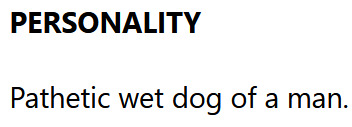Text






I'm starting a collection. Idk what the aesthetic is. Blorbocore
134K notes
·
View notes
Text

For the first time in Saint Louis Zoo history, a cheetah has given birth to 8 cheetah cubs .

Awww look at their faces! I want to cuddle them!!

But I wont.
348K notes
·
View notes
Text
Men were a type of mythological creature¹ similar to elves or homunculi, featured prominently in works of fiction made by fujoshi (a kind of warrior-priest class²) in the early 21st century.
2K notes
·
View notes
Text
I want to draw more but I'm so mentally and physically exhausted because

1K notes
·
View notes
Text
Can we include darebee.com with ao3 and wikipedia on our list of really good nonprofits with excellent services that we stan?
It's a free, no sign-up, no ads fitness resource created by professionals who view this as activism (fitness should be accessible to everyone), and it's very thoughtful and thorough.
Features I really like:
- all instructions for workout routines are diagrammed on single pages with a clean, easy to read layout
- there's 30 or 60 day programs you can follow if you, like me, don't know what to do. they take you through a rotation of workouts so you're working different muscle groups on different day for a specific purpose
- there's so much variety and there's a filter so you can find the level and your goals and type of workout you wanna do
- you don't need any equipment
- some of the programs are RPGs or adventure stories! How's that for motivation. There's also badges and achievements or something but I haven't looked that closely at how that works yet
- they're nerds. they name workouts after D&D classes. There's a Lannistrr workout, a batcave workout, a witcher workout
- I've only scratched the surface
I'm doing this really easy one to start out

18K notes
·
View notes
Text
sound off everyone what’s the worst texture. just in anything. for me it’s ground beef not even a question
52K notes
·
View notes
Text
Listening to a podcast
"Let's take a word from our sponsor."
*Skip ahead a minute* "You can-"
*Skip ahead a minute* "Use code-"
*Skip ahead a minute* "300,000-"
*Skip ahead a minute* "300,000-"
*Skip ahead a minute* "T-shirts-"
*Skip ahead a minute* "Motherfuck-"
*Go back 15 seconds*
63K notes
·
View notes
Text
The 2025 Gender Census is now open!
[ Link to survey ]
The 12th annual international gender census, collecting information about the language we use to refer to ourselves and each other, is now open until 30th August 2025.
It’s short and easy, for most participants it takes 5 minutes or less.

After the survey is closed I’ll process the results and publish a spreadsheet of the data and a report summarising the main findings. Then anyone can use them for academic or business purposes, self-advocacy, tracking the popularity of language over time, and just feeling like we’re part of a huge and diverse community.
If you think you might have friends and followers who’d be interested, please do reblog this blog post, and share the survey URL by email or at AFK social groups or on other social networks. Every share is extremely helpful!
Survey URL: https://survey.gendercensus.com
The survey is open to anyone anywhere who speaks English and feels that the gender binary doesn’t fully describe their experience of themselves and their gender(s) or lack thereof.
Thank you so much!
[ Link to survey ]
16K notes
·
View notes
Photo

The atoms that make up my body aren’t mine, It’s just my time to use them.
215K notes
·
View notes
Text
186 notes
·
View notes
Text
Pet peeve: people online will act disgusted by the term "ageplay" because they don't actually care to read what it means and assume the worst and then turn around and call a pretty woman "dommy mommy" when that is literally ageplay
18K notes
·
View notes
Text
Autism and Independent Living
I posted a survey a month ago on autism and independent living. I have 77 responses, so I'd like to share preliminary data, although I'm still hoping for more responses!
The survey can be found here:
Ability to Live Alone
Over half of the sample could survive living alone. 33% could survive fully independently, 16% needed check-ins once a week, 5% needed check-ins multiple times a week, and 1% needed check-ins daily. 3% needed to be in a supported environment, including a college dorm, with weekly support; 1% could survive in a supported environment with daily support. The remainder needed to live with someone else but could be left alone for a week (11%), a few days (5%), a day (9%), or a few hours (12%). 3% could only be left alone for under an hour.
Just under half of the sample could be healthy living alone. 16% could be healthy fully independently, 15% needed check-ins once a week, 13% needed check-ins multiple times a week, and 3% needed check-ins daily. 4% could be healthy in a supported environment, including a college dorm, with weekly support; 1% could be healthy in a supported environment with daily support. The remainder could be healthy if living with someone else and left alone for a week (4%), a few days (12%), a day (11%), or a few hours (19%). 1% could only be left alone while sleeping, and 1% couldn't be left alone at all.
Only one-third of the sample could thrive living alone. 12% could thrive fully independently, 9% needed check-ins once a week, 12% needed check-ins multiple times a week, and 3% needed check-ins daily. 4% could thrive in a supported environment, including a college dorm, with weekly support; 3% could thrive in a supported environment with daily support. The remainder could thrive if living with someone else and left alone for a week (8%), a few days (5%), a day (14%), a few hours (16%), or under an hour (5%). 4% could only be left alone while sleeping, and 5% couldn't be left alone at all.
34% said their ability to live alone as an adult hadn't changed over time. 14% had never been able to live alone but needed more support now than in the past, and 5% had never been able to live alone but needed less support now than in the past. 9% used to be able to live alone but no longer could, and 12% used to be unable to live alone but now could. For 1%, their ability to live alone had changed multiple times. 22% couldn't answer the question because they weren't an adult or hadn't been an adult long enough to know.
Support Needed
In order to survive, over half of the respondents reported that the most intensive support person that they needed was none (28%), a therapist or other support professional outside of the home (3%), or a loved one visiting (28%). 7% needed to live with a supportive partner, and 28% needed to live with a parent or older caregiver. 7% needed a home-visiting aide, and 1% needed 24/7 1-on-1 support.
In order to be healthy, just under half reported that the most intensive support person that they needed was none (14%), a therapist or other support professional outside of the home (8%), or a loved one visiting (19%). 5% needed to live with a supportive roommate, 5% needed to live with a supportive partner, and 30% needed to live with a parent or older caregiver. 13% needed a home-visiting aide, and 5% needed 24/7 1-on-1 support.
In order to thrive, one-fourth reported that the most intensive support person that they needed was none (5%), a therapist or other support professional outside of the home (3%), or a loved one visiting (17%). 5% needed to live with a supportive roommate, 17% needed to live with a supportive partner, and 13% needed to live with a parent or older caregiver. 24% needed a home-visiting aide, 13% needed 24/7 1-on-1 support, and 3% needed support from multiple aides.
Factors Making It Hard To Live Alone
Respondents were asked what makes it hard for them to live alone. They could say something made it "a little" difficult to live alone, but they could overcome it; "moderately" difficult if it affected their health or well-being; or "extremely" difficult if it made living alone impossible or unsafe.
Almost all respondents identified struggles with starting or changing tasks (23% a little, 40% moderately, 32% extremely); difficulty with change (38% a little, 39% moderately, 18% extremely); difficulty responding to unexpected things (31% a little, 26% moderately, 36% extremely); forgetfulness or inattention (32% a little, 43% moderately, 14% extremely); and fatigue or exhaustion (29% a little, 39% moderately, 17% extremely).
Many named difficulty communicating in emergencies (79%; 25% extremely); sensory sensitivity (79%; 18% extremely); depression and apathy (74%; 16% extremely); anxiety about being alone (69%; 17% extremely); other mental health concerns (66%; 10% extremely); difficulty recognizing emergencies (62%; 13% extremely); self-injurious stimming or sensory seeking (61%; 8% extremely); other physical health concerns (55%; 7% extremely); and falling for scams or trusting dangerous people (51%; 9% extremely).
Less often named were eloping (35%), cognitive impairment or intellectual disability (29%), psychosis or hallucinations (25%), unpredictable physical health emergencies (25%), severe dissociation (22%), catatonia (22%), and addiction (12%).
Tasks Needing Support
Respondents were asked what they need support with. They could say "mild" if they struggled with a task but could do it if they really had to; "moderate" if they needed help at least sometimes or couldn't do it well or consistently on their own; or "severe" if they could almost never do the task alone even if there would be consequences for not doing it.
Difficulty was common across almost all tasks. The only tasks that over half of participants could do with no difficulty were toileting (75% no difficulty), dressing in appropriate clothing (53% no difficulty), and staying safe outside (51% no difficulty).
When looking only at tasks requiring at least some external support sometimes (moderate or severe), many respondents needed help with keeping their house clean (71%), working (66%), cooking healthy meals (65%), making or keeping friends (64%), making big decisions (64%), phone calls (61%), speaking to people in public (60%), managing medication or doctors (60%), managing money or finances (56%), exercising enough (56%), and managing being hurt or sick (53%).
A minority needed help with transportation (49%), shopping (48%), managing emotions (48%), washing clothing (48%), doing the dishes (47%), recognizing when others are harmful (44%), understanding and following directions (42%), eating enough (42%), following a schedule (38%), getting enough sleep (36%), basic hygiene (36%), brushing teeth at least once a day (36%), writing or answering emails (34%), taking medication as directed (30%), and personal grooming (30%).
Consequences of Living Alone
Most participants had had something bad happen to them when they were left alone or tried to live alone; only 8% had experienced no consequences, and 18% had never been left alone long enough to be sure.
Over half (65%) didn't eat enough, including 17% who had to see a doctor because of eating too little and 13% who were hospitalized because of it. 64% didn't brush their teeth enough (30% sometimes skipped; 35% almost never brushed their teeth). 62% didn't bathe or shower enough (23% sometimes skipped; 39% almost never showered or bathed). 58% spent most of the day in bed.
48% accidentally injured themselves, including 1% who had to see a doctor and 5% who had to go the hospital because of it. 47% deliberately self-harmed because of the stress of being alone, including 10% who had to go to the hospital because of it. 42% had a mental health episode because of the stress of being left alone, including 16% who were hospitalized because of it. 42% accidentally broke an object. 38% impulsively spent too much money. 38% reversed their sleep/wake schedule and were awake all night and slept during the day. 30% accidentally didn't take their medication as directed (including 12% who had to go the hospital because of it). 27% experienced their house becoming a hazard due to it being so dirty or cluttered. 19% didn't pay important bills. 18% were abused or assaulted. 17% misused drugs or alcohol. 14% caused a small fire, and 3% caused a house or apartment fire. 14% fell for a scam. 12% accidentally broke part of their house or apartment, such as a heater. 5% became homeless.
Autism and Comorbidities
78% were diagnosed through a formal autism evaluation, 7% were informally diagnosed by a therapist, and 1% had an autism special education eligibility label. 14% were not diagnosed with autism.
Half of the sample was diagnosed with a non-DSM-5 diagnosis (12%), ASD with no level (25%), or level 1 ASD (16%). 15% were diagnosed with level 2 ASD, 5% level 3 ASD, 1% split level 1/2 ASD, 1% split level 2/1 ASD, and 8% split level 2/3 ASD.
The age of diagnosis varied. 5% were diagnosed before age 5, 21% between ages 6 and 12, 22% between ages 13 and 18, 21% between ages 19 and 25, and 14% at age 26 or older.
Over half of the sample had low support needs (37%) or low-moderate support needs (24%) from their autism. 22% had moderate autism support needs, 11% moderate-high autism support needs, and 7% high autism support needs.
Considering all conditions, over half of the sample had low support needs (21%) or low-moderate support needs (30%). 24% had moderate support needs, 13% moderate-high support needs, and 12% high support needs.
The majority of the sample had at least one mental health comorbidity (only 8% none). The most common were anxiety disorders (59%), depression (57%), attention deficit hyperactivity disorder (45%), posttraumatic stress disorder (38%), eating disorders (26%), sleep disorders (24%), specific learning disorders (22%), obsessive compulsive disorder (22%), and dissociative disorders (22%).
The majority of the sample also had at least one physical health comorbidity (24% none). The most common were gastrointestinal disorders or injuries (27%), lung or respiratory disorders or injuries (19%), chronic pain conditions or fibromyalgia (17%), connective tissue disorders (16%), post-viral syndromes such as long-COVID or chronic fatigue syndrome (16%), and neurological disorders or injuries (15%).
Other Demographics
Ages varied but skewed young. 14% of respondents were between ages 13 and 18, 17% were between 19 and 21, 27% were between 22 and 25, 23% were between 26 and 30, and 18% were over 30.
22% of participants were racial/ethnic minorities. Of these, the most common were Hispanic or Latino/a/x (9%) followed by Asian (6%), Black (5%), Native or Indigenous (4%), and Jewish (1%).
Most respondents were AFAB (89%). 35% identified as nonbinary, 30% women, and 29% men. 6% were unsure of their gender.
Most participants found the survey through Tumblr (46%) or Reddit (43%). A minority found it through a friend (5%) or Discord (5%).
9 notes
·
View notes





